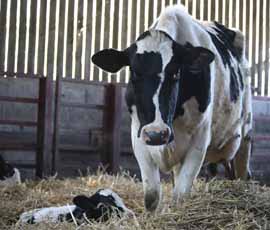Genomic selection of dairy bulls to become reality

Using genomic indices to select dairy bulls will become a reality this year thanks to industry collaboration.
The April bull proof run will include genomic PTAs for two thirds of Holstein bulls on the active list – a step which is heralded as a major step to improving genetic gain.
Speaking at the British Cattle Breeders Conference at Telford Golf and Spa Hotel, Telford, DairyCo’s Marco Winters said having access to genomic indices would help farmers have earlier access to younger sires and drive genetic improvement.
“A modest 15% improvement in genetic gain could be worth about £20 million over 10 years – that’s why it’s important we use new technology,” he explained.
Over the past nine months, industry members have been working together to collate genetic information to produce a genotypic bank. This has included gaining more than 10,000 genotypes from USA and Canada and 3,000 from Italy, providing enough information to produce a SNP key to which individual UK animals can be compared and their performance predicted.
At the same time, phenotypic information (the physical way a gene is expressed), such as milk yields have also been collated. This will enable a correlation to be found between specific genes and specific traits.
Mike Coffey of the SAC stressed that such phenotypic recording was crucial to the success of genomics.
“The phenotype is king in the world of genotype – without these, we will get nowhere.”
Genomics had been implemented that much faster in the dairy industry because of more detailed phenotypic recording through services such as milk recording. The beef industry was that much more behind because of lack of data records.
“There is a massive amount of information available that we are only half using. I will continue on from what I said last year and say I would encourage all farmers to record the sire on passports.”
Dr Coffey also emphasised that genomics was a tool to build on what the industry already had in place and was not a replacement for progeny testing. “This doesn’t mean the end of performance recording, it’s actually the opposite – we need more recording,” he said.
However, both speakers said that the use of genomics emphasised the need to have clear breeding goals in place. “If we are going to go twice as fast, we need to make sure we are going in the right direction. It’s crucial that our breeding programme is right and we must record.”
WHAT WILL THE PROOF LOOK LIKE?
As of April, the proof run will include two lists:
1) A daughter proven list, with the ‘G’ tag for bulls with genomic data and
2) A Young bulls list which will include bulls with just genomic data
The genomic PTAs will look exactly the same as traditional PTAs, but will be accompanied by the ‘G’ flag.
Follow @AlyFW on Twitter to get live tweets from this year’s British Cattle Breeders Conference.
